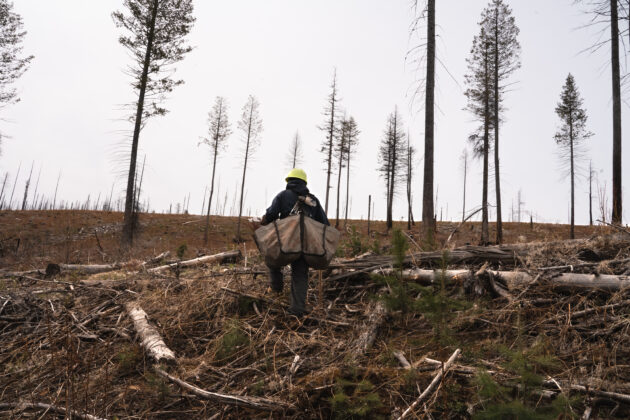Mast Reforestation: A New Era in Forest Restoration and Carbon Capture
Revolutionizing Reforestation: Mast Reforestation’s Ambitious Plan
Mast Reforestation, a Seattle-based company, has made a significant leap in the world of environmental restoration with the announcement of $25 million in new funding and the launch of its innovative "wood vaulting" initiative. This groundbreaking approach involves capturing carbon by burying wildfire-scorched trees underground, preventing them from rotting and releasing CO2 back into the atmosphere. By doing so, Mast not only locks away carbon but also prepares the land for replanting, creating a cyclical process that aids in forest restoration and reduces the risk of future wildfires. This innovative strategy underscores Mast’s commitment to combating climate change while generating revenue through the sale of carbon credits.
The Wood Vaulting Process: Turning Destruction into Opportunity
At the heart of Mast’s new initiative is the concept of "wood vaulting," a method that transforms the remnants of wildfires into a valuable resource for carbon capture. The process begins with identifying trees scorched by wildfires, which would otherwise pose a hazard by fueling future fires or releasing stored carbon as they decompose. Mast collects this biomass and buries it in carefully selected underground locations where the conditions prevent rotting, effectively locking the carbon away for the long term. This approach not only mitigates the immediate risks of wildfire debris but also supports the broader goal of reducing atmospheric carbon.
Beyond the environmental benefits, wood vaulting creates a new revenue stream for Mast. The carbon credits generated from this process can be sold to companies and individuals looking to offset their carbon emissions, providing a sustainable funding mechanism for ongoing forest restoration efforts. This dual-purpose strategy highlights Mast’s ability to merge ecological restoration with economic ingenuity, making it a leader in innovative environmental solutions.
From Drones to Forests: Mast’s Journey to Becoming a Reforestation Leader
Mast Reforestation’s story began nearly a decade ago as a drone startup focused on replanting fire-damaged landscapes. Initially known as DroneSeed, the company pioneered the use of drone technology to scatter seeds over areas ravaged by wildfires, offering a scalable and efficient solution to reforestation challenges. Over time, Mast expanded its scope to include advanced forest management practices, embracing cutting-edge technologies to enhance every stage of the reforestation process.
Today, Mast’s operations span the entire lifecycle of a tree, from seed collection and nurturing to planting and carbon capture. The company uses drone surveys to assess damaged areas, collects pine cones for seed extraction, and employs satellite imagery to guide planting efforts. Seedlings are grown in specialized pucks designed to improve survival rates, and the planted areas are meticulously monitored to ensure successful growth and carbon sequestration. This comprehensive approach underscores Mast’s dedication to restoring ecosystems while leveraging technology for maximum efficiency.
Seeding the Future: Mast’s Expansion into Tree Seed Supply
A critical factor in Mast’s success has been its ability to address challenges in the seed supply chain. Recognizing a shortage of suitable tree seeds, the company took bold steps to secure its own seed sources. In recent years, Mast has acquired three seed companies: Silvaseed, Cal Forest Nurseries, and Siskiyou Seed. These acquisitions have cemented Mast’s position as the largest seed supplier in the Western United States, ensuring a steady supply of high-quality seeds for its reforestation efforts.
In addition to securing seed supplies, Mast is modernizing these businesses by integrating new technologies. This not only improves operational efficiency but also ensures that the seeds used in replanting efforts are well-suited to their environments, maximizing the chances of successful growth. By controlling every step of the reforestation process, from seed to sapling, Mast is able to scale its impact while maintaining the highest standards of quality and sustainability.
Funding the Future: Mast’s Series B Round and Strategic Partnerships
Mast’s latest round of funding, a $25 million Series B investment, is a testament to the company’s growing influence in the reforestation and carbon capture space. Co-led by new investor Pulse Fund and returning investor Social Capital, the round also includes contributions from Elemental Impact, Spero Ventures, Thistledown Capital, Julius Genachowski, and Resilience Reserve. Returning investors such as Seven Seven Six, Gaingels, and Climate Capital further demonstrate the confidence in Mast’s mission and business model.
Beyond its investors, Mast has established strategic partnerships to amplify its impact. One such collaboration is with the nonprofit One Tree Planted, which facilitates the sale of carbon credits for planting projects. Mast is now working to expand this initiative to include credits generated through its wood vaulting program. By creating multiple revenue streams and fostering partnerships, Mast is building a robust financial foundation to support its ambitious goals.
A Vision for the Future: Combining Innovation and Ecology
Mast Reforestation’s journey from a drone-based startup to a comprehensive forest restoration leader is a story of innovation and ecological stewardship. By combining cutting-edge technology with a deep understanding of forestry, the company is redefining how we approach reforestation and carbon capture. The introduction of wood vaulting is just the latest chapter in this ongoing story, offering a powerful solution to the dual challenges of wildfire management and climate change.
As Mast continues to scale its operations and explore new opportunities, its commitment to restoring forests and sequestering carbon remains unwavering. With a growing portfolio of technologies, strategies, and partnerships, Mast is poised to play a pivotal role in the global effort to combat climate change. The company’s work not only benefits the environment but also sets a precedent for how businesses can merge profitability with purpose, creating a sustainable future for generations to come.












